#duke charles edward of saxe-coburg and gotha
Text

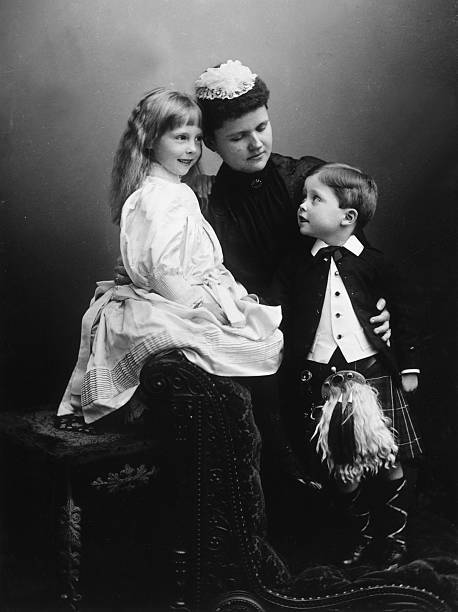
Helena, Duchess of Albany and her two children, Princess Alice and Prince Charles Edward, late 1880s.
#duchess helena of albany#princess alice of albany#prince charles edward duke of albany#duke charles edward of saxe-coburg and gotha#british royal family#late 1880s#1880s
21 notes
·
View notes
Note
Sofia looks SO much like her 1st cousin 5 times removed, Prince Charles Edward Duke of Saxe Coburg and Gotha, and his daughter Sybilla (current mother of King Carl XVI Gustafson of Sweden!)
Hi! May I ask how are they related??
Yes of course!
So Sofia’s grandmother is Queen Sofia of Spain aka Princess Sofia of Greece (before marriage), her mother was of German blood and her name was Princess Frederica, Sofia’s Great-Grandmother. Frederica’ mother was named Princess Victoria-Louise of Prussia and was Sofia’s Great-Great-Grandmother. Victoria-Louise’s father was Kaiser Wilhelm II, Sofia’s Great-Great-Great-Grandfather.
Wilhelm’s 1st cousin (for example: Prince William and Princess Beatrice of the UK) was Prince Charles Edward of Saxe Coburg and Gotha through his mother’s (German Empress Victoria aka Victoria Princess Royal) brother Prince Leopold Duke of Albany (whose son was Charles Edward. Because Charles Edward and Wilhelm were 1st cousins, that makes Victoria Louise and Sybilla (Charles Edward’s daughter) 2nd cousins since their parents were first cousins. Charles Edward was therefore 5 times removed from Sofia, and Sybilla was 4 times removed.
Here is a quick family tree (not my best work but I tried lol)

I hope this helps and thank you for asking!
11 notes
·
View notes
Photo
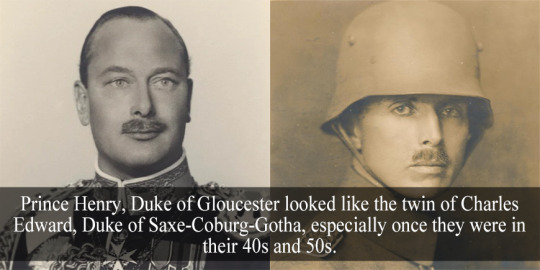
“Prince Henry, Duke of Gloucester looked like the twin of Charles Edward, Duke of Saxe-Coburg-Gotha, especially once they were in their 40s and 50s.” - Submitted by Anonymous
15 notes
·
View notes
Text
Queen Elizabeth II death: Who is in the Queen's family tree?

The House of Windsor, as we understand it nowadays, started in 1917 whilst its own circle of relatives modified its call from the German "Saxe-Coburg-Gotha." Queen Elizabeth's grandfather, King George V, became the primary Windsor monarch. Meanwhile, it is essential; that the royals we see today are the descendants of King George and Queen Mary.
Queen Elizabeth's grandmother Queen Mary turned into a royal through birth; her great-grandfather turned into King George III. Edward, the eldest son of George V and Queen Mary, became King after her father's loss of life in 1936 which threw the country into crisis months later when he proposed to Wallis Simpson, an American divorced socialite.
There was no split between church and state at that time. As a result, Edward was the head of the Church of England, which at the time, divorced people were not allowed to remarry, and thus his marriage was opposed.
After only one year on the throne, Edward III voluntarily abdicated the throne addressing the nation on the radio with these words; "I have found it impossible to carry on the heavy burden of responsibility and to discharge the duties of the king, as I would wish to do, without the help and support of the woman I love."
His more youthful brother, the duke of York, was proclaimed King George VI on December 12.
The Queen became the 6th lady to ascend the British throne in February 1952, after his father, King George IV, passed away. She served the British monarchy for over 70 years.
Following Queen Elizabeth II death at 96, her eldest son immediately ascends the throne as the King of the British monarchy, putting his eldest son, Prince William, the Duke of Cambridge, first in line to the throne.
Regarding marital relationships, Queen Elizabeth married her third cousin, Prince Phillip, the Duke of Edinburgh, in November 1947, who both were Queen Victoria's great-great-grandchild.
Queen Elizabeth had only sibling sister, Princess Margret, Countess of Snowdown, who died in 2002.
Among her children, Prince Charles was the prospective heir to the throne at the age of three and married Princess Diana from 1981 to 1996, with whom they had two children; Prince William and Harry.
Princess Diana's death was caused by a car crash in France's Capital, Paris, along with the Egyptian film producer Dodi Fayed and driver Henri Paul.
Prince William, Duke of Cornwall and Cambridge, heir apparent to the British throne, married Catherine Elizabeth Middleton in 2011 at West minster Abbey. The couples have three children together; Prince George, 9; Princess Charlotte, 7; Prince Louis, 4.
Prince Harry, real name (Henry Albert David), was born September 15, 1984, a member of the British royal family and fifth to the line of successors to the British throne. He underwent Royal Military Academy Sandhurst.
Prince Harry married Meghan Markle in 2018 at St. George's Chapel, Windsor Castle.
Under the protocols started by King George V in 1917, the youngsters and grandchildren of a sovereign have to be automatically called Her Royal Highness or His Royal Highness (HRH) and prince or princess.
According to the British media reports, the Duke and Duchess of Sussex's son, Archie Mountbatten-Windsor, is now technically a prince following the demise of the Queen- a name which Meghan controversially claimed became formerly denied to him due to the race he belongs to.
His more youthful sister, Lilibet` Lili' Mountbatten-Windsor, is likewise entitled to be a princess following the demise of the Queen and, together with her grandfather, the Prince of Wales, turning into King.
Other close relative includes Prince Andrew, Duke of York, 62, the third of the Queen's four children and nine to the throne. He served in the British Royal Navy for 22 years, and during the Falklands War, he served as a helicopter pilot.
Princess Beatrice, 10th in the line of succession to the British throne, married real estate developer Edoardo Mapelli Mozzi in a non-public rite in July 2020.
Princess Eugenie, the younger York sister as described royally, is the 12th in the line of succession after her cousin Prince Harry.
The Queen's next of Kin also consists of Prince Edward, Earl of Wessex, Prince Eugenie, Lady Louise Windsor, and Anne, Princess Royal, among many other ascendants and descendants.
0 notes
Photo
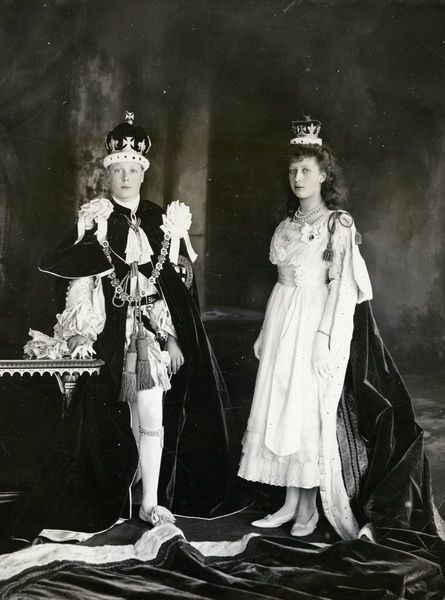
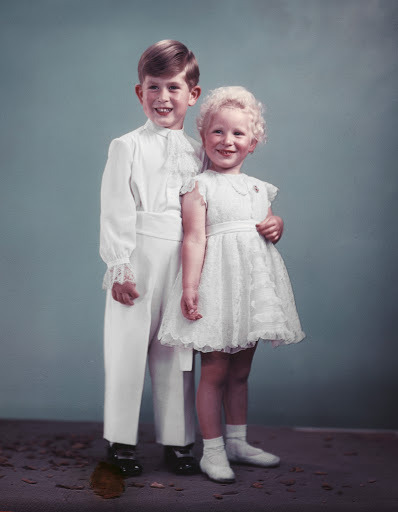
Two generations of royal titleholders at the time of their parent/s’ coronation.
On the left: TRH Edward, Prince of Wales & Mary, Princess Royal in regalia for their parents’ coronation in 1911.
On the right: TRH the Prince Charles & the Princess Anne, future Prince of Wales and Princess Royal.
#prince charles#princess anne#1952#1953#prince edward#princess mary#prince of wales#princess royal#duke of windsor#duke of cornwall#edward viii#countess of harewood#windsor#saxe-coburg and gotha#united kingdom#regalia#royalty#monarchy#children#teenagers#vintage
23 notes
·
View notes
Text
Victoria I (Queen of UK of Great Britain and Ireland) (24 May 1819 – 22 January 1901)
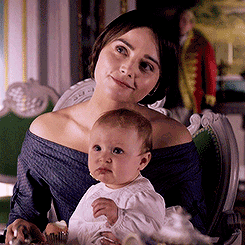
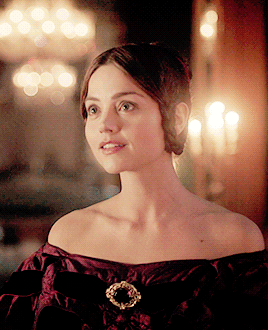
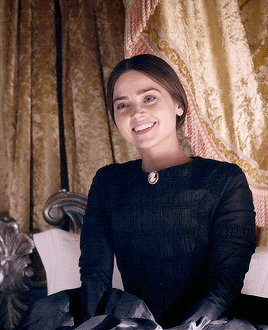
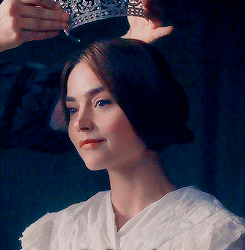

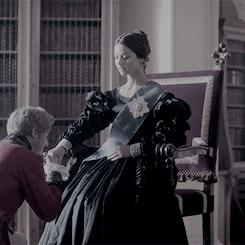

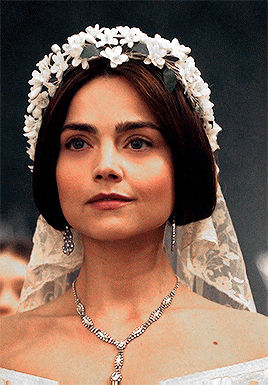

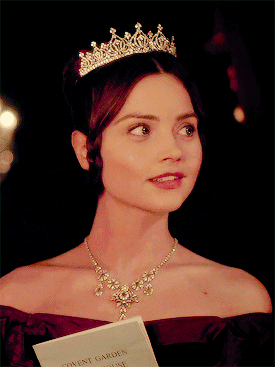
Daughter of Prince Edward (Duke of Kent and Strathearn) and Princess Victoria of Saxe-Coburg-Saalfeld.
Wife of Prince Albert of Saxe-Coburg and Gotha
Mother of Victoria (Princess Royal), Edward VII, Princess Alice, Prince Alfed (Duke of Saxe-Coburg and Gotha), Princess Louise, Princess Helena, Prince Arthur (Duke of Connaught and Strathearn), Prince Leopold (Duke of Albany), and Princess Beatrice.
Grandmother of Wilhelmina II (King of Germany and Prussia), Princess Charlotte of Prussia, Prince Henry of Prussia, Prince Sigismund of Prussia, Princess Viktoria of Prussia, Prince Waldemar of Prussia, Princess Sophia of Prussia, Princess Margaret of Prussia, Prince Albert Victor (Duke of Clarence and Avondale), George V, Louise (Princess Royal), Princess Victoria, Princess Maud of Wales, Prince Alexander John of Wales, Princess Victoria of Hesse and by Rhine, Elizabeth Feodorovna (Grand Duchess of Russia), Princess Henry of Prussia, Ernest Louis (Grand Duke of Hesse), Prince Friedrich of Hesse and by Rhine), Alexandra Feodorovna (Empress of Russia), Princess Marie of Hesse and by Rhine, Alfred (Hereditary Prince of Saxe-Coburg and Gotha), Marie of Romania, Victoria Feodorovna (Grand Duchess of Russia) Princess Alexandra of Saxe-Coburg and Gotha (Princess Consort of Hohenlohe-Langenburg), Princess Beatrice of Saxe-Coburg and Gotha (Duchess of Galliera), Prince Christian Victor of Schleswig-Holstein, Albert (Duke of Schleswig-Holstein), Princess Helena Victoria of Schleswig-Holstein, Princess Marie Louise of Schleswig-Holstein (Princess Aribert of Anhalt), Prince Harald, Princess Margaret of Connaught (Crown Princess of Sweden), Prince Arthur of Connaught, Princess Patricia of Connaught (Lady Patricia Ramsay), Princess Alice (Countess of Athlone), Charles Edward (Duke of Saxe-Coburg and Gotha), Alexander Mountbatten (1st Marquess of Carisbrooke), Victoria Eugenie of Battenberg (Queen of Spain), Lord Leopold Mountbatten, and Prince Maurice of Battenberg
Mother-in-law of Fredrick III (Emperor of Germany), Princess Alexandra of Denmark, Louis IV (Grand Duke of Hesse and by Rhine), Grand Duchess Maria Alexandrovna of Russia, Prince Christian of Schleswig-Holstein, John Campbell (9th Duke of Argyll), Princess Louise Margaret of Prussia, Princess Helena of Waldeck and Pyrmont, and Prince Henry of Battenberg.
19 notes
·
View notes
Text
In The Atlantic: "Among the challenges Prince Philip faced in becoming Queen Elizabeth's consort was carving out a new masculinity—but he tackled it anyway, @helenlewis writes"
https://twitter.com/TheAtlantic/status/1380607799118467073?s=20
Helen Lewis is a staff writer at The Atlantic, author of "Difficult Women: A History of Feminism in 11 Fights", and a presenter on BBC Radio 4's The Spark.
Like other members of the British Royal Family, Prince Philip’s reputation is now defined by his portrayal in The Crown: a stern father, a reluctant consort, a man’s man who struggled to play second fiddle to his wife. It could be worse.
The Queen’s husband has died two months short of his 100th birthday, and his death inevitably invites comparisons between the world he was born into and the one he has left behind. He was born a prince on the island of Corfu, in the line of succession to both the Greek and Danish thrones, but his uncle, King Constantine I of Greece, abdicated when Philip was just a year old, and the family had to escape to France. (The baby Philip was famously carried away from his home in a fruit box.) His four elder sisters all married German princes, and he saw them only sporadically as he was raised at boarding schools. His mother was committed to a mental institution when he was 9, and later joined a religious order.
The First World War had already created an awkward distance between the British royals and their German cousins: George V renounced all his German titles in 1917, and the Saxe-Coburg-Gothas became the Windsors. The outbreak of hostilities against Nazi Germany two decades later prompted another schism in the royal families of Europe. The Queen’s uncle, the former Edward VIII, was known to be sympathetic to the Nazis, and so was dispatched to the Bahamas for the duration of the war. Philip had been educated in Germany until the Jewish founder of his school fled the Nazis, moved to Scotland, and set up a new boarding school called Gordonstoun. Philip followed him there, and when the call came, the prince served in the British navy.
This fractured youth left Philip restless, isolated, and independent. When he married Princess Elizabeth, in 1947, his German relatives were not invited to the ceremony. Still, the match looked to be perfect: Back then, tradition held that an heir to the British throne should not marry a “commoner.” Philip was not just royal, but handsome and brave. And unlike the man Elizabeth’s sister, Margaret, fell in love with, he had not been married before.
He was also a man who had to take second place to his wife—a phenomenon experienced by more and more men as the 20th century wore on, but still an unusual one. Even today, less than a third of men in straight couples earn less than their wives, and less than 3 percent of men take their wife’s surname on marriage. At their wedding ceremony, Princess Elizabeth had promised to “love, honour, and obey” Philip, but she was adamant that the Windsors would remain the Windsors, rather than becoming the Edinburghs. (Philip renounced his Greek and Danish titles before the wedding, and was granted the British title of Duke of Edinburgh.) He felt this humiliation acutely, once describing himself as a mere “amoeba.” When Elizabeth became Queen in 1952, it meant the end of his career in the navy. He was a kept man, a consort, No. 2 in the pecking order.
Philip was partly mollified by his wife’s decision to defer to him on family matters, although that sometimes had poor consequences. He chose to send Prince Charles, his eldest son, to his beloved Gordonstoun. But the sensitive Charles hated the dour, disciplinarian Scottish school. Indeed, the parenting styles of the Royal Family reflect a broader shift in upper-class British attitudes toward children: Like the Queen’s cut-glass accent, they have softened over the years. Once the belief was that children needed to toughen up, that whatever doesn’t kill you makes you stronger. Now Charles’s sons, William and Harry, are pictured hugging their children. It’s hard to imagine who would have hugged the young Philip, alone in a strange land, with an absent father and troubled mother.
The latest season of The Crown focused on the relationship between the Queen and Britain’s first female prime minister, Margaret Thatcher. The untold story is that of Thatcher’s husband, Denis. Like Prince Philip, he faced a challenge few alpha males had confronted before: How would a traditionally minded man cope with the very nontraditional role of support act to his wife? Denis found solace in sports. He was a rugby referee for many years, and then turned to golf. Meetings at the prime minister’s country residence, Chequers, would be interrupted by the sound of Denis using the lawn as a putting green. He carved a new type of masculine persona, in contrast to his wife’s bluebottle diligence: supremely relaxed, self-assured, a man who enjoyed a drink and a fast car.
Philip found that challenge harder, but he applied himself to it. In 1956, he founded the Duke of Edinburgh’s Award, which was designed to teach young people self-reliance. Medals were given for serving one’s community, starting a business, or trekking for miles across Britain’s rainiest moors, armed only with a map and compass. Sent around the world as a representative of Britain, Philip became known for puncturing pompous diplomatic events with aristocratic bluntness. He developed a reputation for what were then referred to as “gaffes,” but what we would now call casual racism. (“If you stay here much longer you’ll all be slitty-eyed,” he told a group of British students in China in 1986, and while looking at an electrical circuit a few years later, he remarked: “It looks as if it was put in by an Indian.”) When I was growing up in the 1990s, this was the popular perception of Philip: Britain’s Poshest Racist. He was a staple target of left-wing comedians and a hero to those who felt that “political correctness” was going too far. Even now, Amazon is full of books with titles such as Do You Still Throw Spears at Each Other?: 90 Years of Glorious Gaffes From the Duke.
His reputation has improved since then, because he took the Denis Thatcher route: a vow of silence. Philip gave up many of his royal duties on his 90th birthday, in 2011, and retired entirely from public life in 2017. By then, he had completed 22,219 solo royal engagements. At the time of his death, he and Queen Elizabeth II had been married for 73 years. He might have been a reluctant consort, but he was also an energetic one. The Archbishop of Canterbury, who conducted Meghan Markle and Prince Harry’s wedding ceremony, recently described royal duties as a “life sentence without parole,” and Britain came to respect Philip’s decades of public service.
Once the initial, respectful tributes are over, Philip’s reputation will be as contested as that of Britain’s great wartime prime minister, Winston Churchill, whose early colonial career makes for uncomfortable reading. Philip was a man of his age. He was born into a world of deference and tradition that no longer exists: Greece has been a republic since 1973, while the heir to the Danish throne is married to an Australian marketing consultant. In 1937, the 16-year-old Philip walked through German streets for his sister’s funeral as onlookers gave Nazi salutes. His grandson Harry, meanwhile, married a biracial American actor, moved to California, and launched a podcast.
The 20th century was a hell of a ride, and one in which men’s expectations for their lives changed as dramatically as women’s. No one encapsulated that quite as strangely, or as remarkably, as a man who lived for nearly a century himself.
140 notes
·
View notes
Photo

Day Of The Wedding (Part 3) But Charlotte did not forget her beloved Margaret. 'To show you how constantly you occupy my thoughts,' she wrote two days later, 'my last word was with Lieven to intreat her to give you a faithful account, & to my maid just as I drove off to go & tell you how I looked & was ...'
#augusta of the united kingdom#carlton house#charles manners-sutton archbishop of canterbury#charlotte of mecklenburg-strelitz (queen of the united kingdom)#edward duke of kent#elizabeth of the united kingdom(landgravine of hesse-homburg)#frederica charlotte of prussia duchess of york and albany#frederick duke of york#george IV (prince of wales and prince regent)#mary duchess of gloucester and edinburgh#mrs alicia campbell#oatlands#prince leopold of saxe-coburg-gotha (later king of the belgians)#princess charlotte of wales#princess dorothea von lieven née benckendorff#prinny&039;s daughter: a biography of princess charlotte of wales#sophia of the united kingdom#the hon.margaret mercer elphinstone#thea holme#william howley bishop of london#william IV king of the united kingdom (duke of clarence)
0 notes
Photo
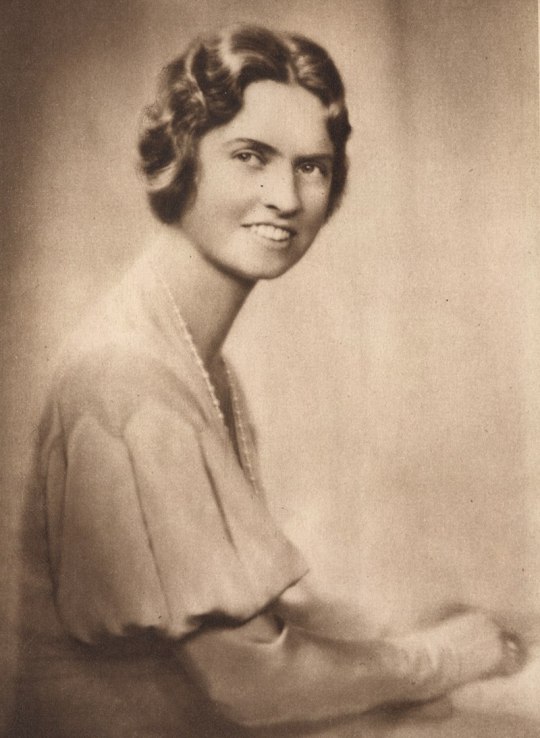
Princess Sibylla of Saxe-Coburg and Gotha (18 January 1908 – 28 November 1972) was a member of the Swedish royal family and the mother of the current King of Sweden, Carl XVI Gustaf.
Born into the House of Saxe-Coburg and Gotha, Sibylla was the daughter of Charles Edward, the last duke of Saxe-Coburg and Gotha. She became a Swedish princess when she married Prince Gustaf Adolf, Duke of Västerbotten in 1932. She thus had the prospect of one day becoming queen consort of Sweden, but the prince was killed in an airplane crash in 1947 and did not live to ascend the Swedish throne. Sibylla thus never became Crown Princess or Queen herself since her husband died before his father and his grandfather King Gustav V. Nor did she live to see her son become king of Sweden in 1973.
#Sibylla of Saxe-Coburg and Gotha#House Saxe-Coburg and Gotha#XX century#people#portrait#photo#photography#Black and White
3 notes
·
View notes
Photo
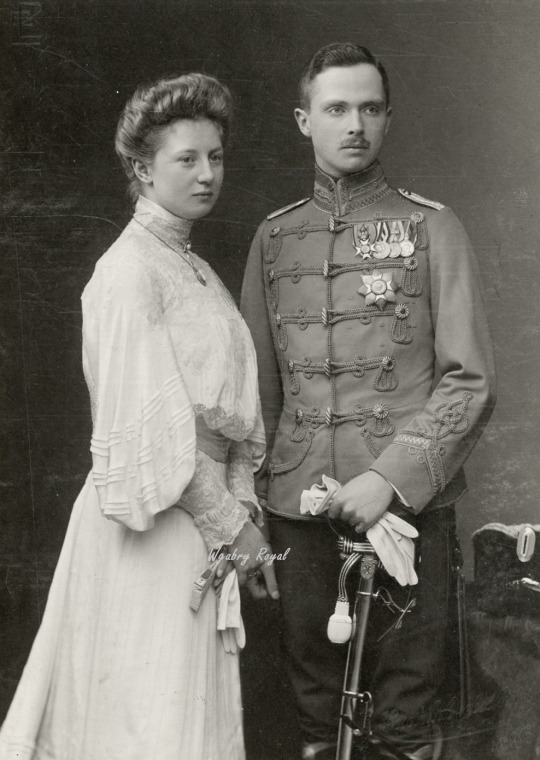
Charles Edward, Duke of Saxe-Coburg and Gotha and his wife Princess Victoria Adelaide of Schleswig-Holstein-Sonderburg-Glücksburg, the eldest daughter of Frederick Ferdinand, Duke of Schleswig-Holstein-Sonderburg-Glücksburg and his wife Princess Karoline Mathilde of Schleswig-Holstein-Sonderburg-Augustenburg. He was a male-line grandson of Queen Victoria and Prince Albert, he was also until 1919 a Prince of the United Kingdom and from birth held the British titles of Duke of Albany, Earl of Clarence and Baron Arklow. His father was Prince Leopold, Duke of Albany, the eighth child of Queen Victoria and Prince Albert. His mother was Princess Helen of Waldeck and Pyrmont, the fourth daughter of George Victor of Waldeck and Pyrmont and of his first wife Princess Helena of Nassau.
43 notes
·
View notes
Text
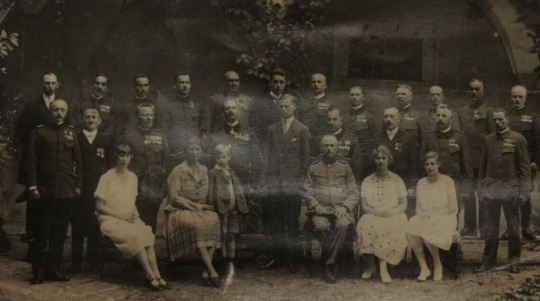
The Ducal Family of Saxe-Coburg and Gotha with some officers, mids 1920s.
Front row: Princess Feodora of Denmark, Duchess Victoria Adelaide, Prince Friedrich Josias, Hereditary Prince Johann Leopold, Duke Charles Edward, Princess Sibylla and Princess Caroline Mathilde.
#princess feodora of denmark#duke charles edward of saxe-coburg and gotha#duchess victoria adelaide of saxe-coburg and gotha#hereditary prince johann leopold of saxe-coburg and gotha#princess sibylla of saxe-coburg and gotha#princess caroline mathilde of saxe-coburg and gotha#prince friedrich josias of saxe-coburg and gotha#saxe-coburg and gotha#german royalty#german royal#mids 1920s#1920s
11 notes
·
View notes
Text
Timeline (IRL Event, Cannon Event, This AU Event.) [Arcs Not Included]
1344, Sebastian met Pharaoh Smenkhkare.
1346-1353, Sebastian Indirectly killed 200 Million people by beginning the spread of The Plague.
June 26th 1483, Duke Richard and King Edward V were killed by their uncle, King Richard III. [Haunted Castle Arc]
May 24th 1819, Princess Alexandrina Victoria of Kent was born. (Later known as Queen Victoria.)
August 26th 1819, Albert of Saxe-Coburg and Gotha was born (Later Known as Prince Albert.)
December 8th 1819, Tanaka Fujimura was born in Japan.
April 5th 1830, Claudia Phantomhive (née Hargreeves) was born.
August 29th 1839, Baron Kelvin was born. (Full name Jasper Kelvin)
February 10th 1840, Queen Victoria and Prince Albert married.
April 8th 1845, Lady Francis Phantomhive (Later Marchioness Francis Midford)
1848, Baldroy was born in Arizona America. (Full name Baldroy Griffith)
June 13th 1851, Lord Vincent Phantomhive is Born.
1852, Marquise Alexis Midford was born.
March 9th 1853, Baroness Rachel Dalles was born. (Later Lady Rachel Phantomhive)
December 14th 1856, Baroness Angelina Dalles was born. (Later Burnett)
April 2ed 1857, 'Doctor' was born. (Full name: Kurtis Kelvin)
1858, Lau was born. (Full name Lau Qīng)
August 24th 1858, Arshad Satyendra Iyer was born (Currently referred to by Agni.)
1861, Baldroy Fought in the American Civil War.
December 14th 1861, Prince Albert Died.
November 26th 1862, Queen Victoria Formed an Agreement with Ash/Angela Blanc.
April 2ed 1863, Joker was born. (Full name: Jakub Taylor)
August 8th 1863, Nina Hopkins was born.
April 14th 1863, Comet was born. (Real name: Didyme Carmichael)
1863, Lord Charles Phipps was born.
May 22ed 1864, Mally 'Beast' was born. (Full name Mally Cook)
1864, Mey-Rin was born. (full name Mey-Rin Māotóuyīng)
1864, Lord Charles Grey was born.
1864, Dagger was born. (Full name: Harlan Day)
1865, Jumbo was born. (Full Name: Thomas Lee)
July 13th 1866, Claudia Phantomhive Died.
1868, 'Snake' was Born. (Real name Levi Böhm)
May 8th 1869, Lord Edward Midford was born.
1870, Ran-Mao was born. (Full name Ran-Mao Jīan)
1870, Cheslock was born. (Full name Alfred Cheslock)
1871, Prince Soma Asman Kadar was born in India.
1872, Peter was born. (Formerly known as Test Subject Elf)
1872, Test Subject Zwölf was born. ( Later Known as Finian Ames)
1872, Wendy was born. (Formerly known as Test Subject Sechszehn)
April 17th 1874, Lady Elizabeth Midford was born.
November 5th 1874, Jim Macken was born (Later Known as Alois Trancey / Earl Alois Trancey.)
November 19th 1874, Rachel and Vincent Phantomhive got married.
November 27th 1875, Freckles/Doll was born. (Full name: Reven-Niaga Stevens)
December 14th 1875, The Ciel Twins were born.
1880, Octavius Ciel Phantomhive developed Ashma.
December 14th 1885, The Phantomhive Manor was attacked and only the Twins and Tanaka survived. The Twins were Captured and sold.
January 1886, Reginald Ciel Phantomhive was killed by cultist causing His Twin to summon a demon (Later Known as Sebastian Michaelis) and made a contract with them.
April 3rd 1888, The Jack the Ripper Murders began.
November 9th 1888, The Jack the Ripper Murders Ended.
January 7th 1889, Alois Trancey Formed a Contract with a Demon (Later Known as Claude)
18 notes
·
View notes
Photo
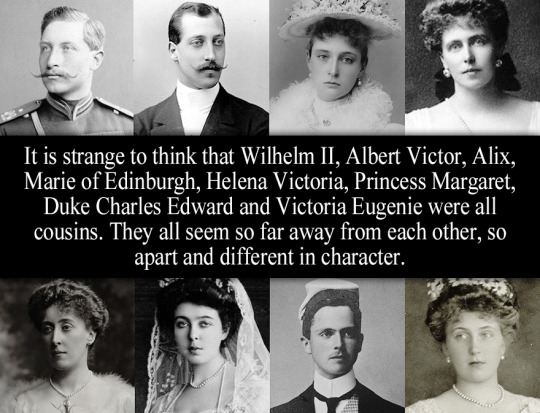
“It is strange to think that Wilhelm II, Albert Victor, Alix, Marie of Edinburgh, Helena Victoria, Princess Margaret, Duke Charles Edward and Victoria Eugenie were all cousins. They all seem so far away from each other, so apart and different in character.” - Submitted by Anonymous
#prince albert victor#queen marie of romania#Princess Helena Victoria#princess margaret of connaught#charles edward duke of saxe coburg and gotha#Queen Victoria Eugenie#wilhelm ii#empress alexandra feodorovna
71 notes
·
View notes
Text
ADOLPHUS CAMBRIDGE
1st Marquess of Cambridge
(born 1868 - died 1927)

picured above is a portrait of the Duke of Teck, by Fülöp de László from 1906
-------------------- ~ -------------------- ~ --------------------
SERIES - Descendants of the Monarchs of Ireland: Adolphus was a great-grandson of George III, King of the United Kingdom, the King of Ireland from 1760.
-------------------- ~ -------------------- ~ --------------------
ADOLPHUS CHARLES ALEXANDER ALBERT EDWARD GEORGE PHILIP LOUIS LADISLAUS was born in 1868, at Kensington Palace in London. He was the eldest son of Franz, Duke of Teck and Princess Mary Adelaide of Cambridge, and thus a PRINCE OF TECK from birth.
Besides having German roots the TECK FAMILY (being a morganatic cadet branch of the House of Württemberg) lived in London where his mother received an annuity and had been granted apartments in Kensington Palace by her cousin Queen Victoria of the United Kingdom.
From an early age he entered in the service of the Royal Army and served in the regiment of his uncle George, Duke of Cambridge.
His older sister Princess Victoria Mary married George, Duke of York in 1893 and the next year the Prince of Teck married Lady MARGARET EVELYN, the youngest daughter of Hugh Grosvenor, 1st Duke of Westminster and his first wife Lady Constance Sutherland-Leveson-Gower. With her he had four children.
Around 1899/1900 he was sent to fight in the Second Boer War in Africa, where his wife and sister-in-laws visited him.
He succeeded his father as DUKE OF TECK in 1900, a title in the Kingdom of Württemberg.
In 1910 his brother-in-law succeeded in the United Kingdom as King George V, and by 1914 he also made him Governor and Constable of Windsor Castle.
Between 1914-16 he resumed his Army career to fight in World War I but his health forced him to retire early.
During the War there were heavy anti-German feelings in the United Kingdom and the King decided to ban the use of German titles in Britain. This decision also led to many families to abandon their German family names. The Royal Family changed their House name from Saxe-Coburg and Gotha to Windsor, and the TECKS became CAMBRIDGE in honour of their grandfather the late Adolphus, Duke of Cambridge.
At the King's order British nobles renounced their German titles in 1917 and for a brief period the former Duke of Teck became known as Sir ADOLPHUS CAMBRIDGE. But the King soon created him as MARQUESS OF CAMBRIDGE, EARL OF ELTHAM and VISCOUNT NORTHALLERTON
After the War ended, he and his wife settled in the English countryside near Shrewsbury, where the Marquess of Cambridge died in 1927, aged 59.
-------------------- ~ -------------------- ~ --------------------
Lord George Cambridge, his eldest son, succeeded in his British titles. And as his other son Lord Frederick died in 1940, fighting in World War II, the Teck/Cambridge family became extinct in 1981 with the death of Lord George without heirs.
-------------------- ~ -------------------- ~ --------------------
Check my posts about ADOLPHUS' ancestors and his connections to the Monarchs of Ireland!
In a span of four generations ADOLPHUS was related to the Monarchs of Ireland through his mother…
His mother was Princess Mary Adelaide of Cambrigde.
His grandfather was Adolphus, Duke of Cambridge.
His great-grandfather was George III, King of the United of Kingdom - the King of Ireland between 1760-1800/01.
#adolphus#lord adolphus#marquess of cambridge#duke of teck#cambridge family#house of teck#teck#german royals#german royalty#german nobility#british royals#british nobility#royals#royalty#monarchy#monarchies#royal history#german history#british history#european history#world history#history#history lover#19th century#20th century#world war one#victorian era#queen victoria#edward vii#george v
37 notes
·
View notes
Text
All the Queens of England (1066 Onward)
Matilda of Flanders (Born 1031, died 1083)(Married to William the Conqueror)
Matilda of Scotland (Born 1080, died 1118)(Married to Henry I)
Adeliza of Louvain (Born 1103, Died 1151)(Married to Henry I)
Matilda I, Countess of Boulogne (Born 1105, Died 1152)(Married to King Stephen)
Eleanor of Aquitaine (Born 1122, Died 1204)(Married to Henry II)
Berengaria of Navarre (Birth date disputed, somewhere around 1165–1170, died 23rd December 1230)(Married to Richard I)
Isabella Countess of Gloucester (Birth date disputed, born either 1173 or 1174, died 14 October 1217) (Married to King John)
Isabella of Angoulême (Birth date disputed, born around 1186 -1188, died 4th June 1246)(Married to King John)
Eleanor of Provence (Born 1223, died 24th/25th June 1291)(Married to Henry III)
Eleanor of Castile (Born 1241, died 28th November 1290)(Married to Edward I)
Margaret of France (Born 1279, Died 14th February 1318)(Married to Edward I)
Isabella of France (Born 1295, Died 22th August 1358)(Married to Edward II of England)
Philippa of Hainault(Birth date disputed, born between 1310-1315, Died 15th August 1369)(Married to Edward III)
Anne of Bohemia (Born 11th May 1366, Died 7th June 1394)(Married to Richard II)
Isabella of Valois (Born 9th November 1389, died 13th September 1409)(Married to Richard II)
Joan of Navarre (Born 1368, died 10th June 1437)(Married to Henry IV)
Catherine of Valois (Born 27th October 1401, died 3rd January 1437) (Married to Henry V)
Margret of Anjou (Born 23rd March 1430, died 25th August 1482)(Married to Henry VI)
Elizabeth Woodville (Born 1437, died 8th June 1492)(Married to Edward IV)
Anne Neville (Born 11th June 1456, died 16th March 1485) (Married to Richard III)
Elizabeth of York (born 11th February 1466, died 11th February 1503)(Married to Henry VII)
Catherine of Aragon(born 16th December 1485, died 7th January 1536)(Married to Henry VIII)
Anne Boleyn(Birth date disputed, born around 1501-1507, died 19th May 1536)(Married to Henry VIII)
Jane Seymour(Born 1506, died 24th October 1537)(Married to Henry VIII)
Anne of Cleves (Born 1515, Died 16th July 1557)(Married to Henry VIII)
Catherine Howard (Born 1523, Died 13 February 1542)(Married to Henry VIII)
Catherine Parr (Born 1512, died 5th September 1548)(Married to Henry VIII)
Lady Jane Grey (Birth date disputed, born either 1536 or 1537, died 12th February 1554) (The 9 days Queen)(married to Lord Guildford Dudley)
Mary I (Born 18th February 1516, died 17th November 1558) (Married to Philip II of Spain)
Elizabeth I (Born 7th September 1533, died 24 March 1603)(Never Married)
Anne of Denmark (Born 12th December 1574, died 2nd March 1619)(Married to James VI and I)
Henrietta Maria of France (Born 25th November 1609, died 10 September 1669) (Married to Charles I)
Catherine of Braganza (Born 25th November 1638, died 31 December 1705)(Married to Charles II)
Mary of Modena (Born 5th October 1658, died 7th May 1718) (Married to James II & VII)
Mary II (Born 30th April 1662, died 28 December 1694)(Co-ruled and was married to William III & II)
Anne (Born 6th February 1665, Died 1 August 1714) (Married to Prince George of Denmark)
Caroline of Ansbach (Born 1st March 1683, died 20 November 1737) (Married to George II)
Charlotte of Mecklenburg-Strelitz (Born 19th May 1744, died 17th November 1818) (Married to George III)
Caroline of Brunswick (born 17 May 1768, died 7th August 1821) (Married to George IV)
Adelaide of Saxe-Meiningen (Born 13th August 1792, died 2nd December 1849) (Married to William IV)
Queen Victoria (Born 24 May 1819, died 22nd January 1901)(married to Prince Albert of Saxe-Coburg and Gotha)
Alexandra of Denmark (Born 1st December 1844, died 20 November 1925)(Married to Edward VII)
Mary of Teck (Born 26th May 1867, died 24th March 1953)(Married to George V)
Queen Elizabeth The Queen Mother (Born 4th August 1900, died 30 March 2002)(Married to George VI)
Queen Elizabeth II (Born 21 April 1926) (Married to Prince Philip, Duke of Edinburgh)
8 notes
·
View notes
Text
Throwback
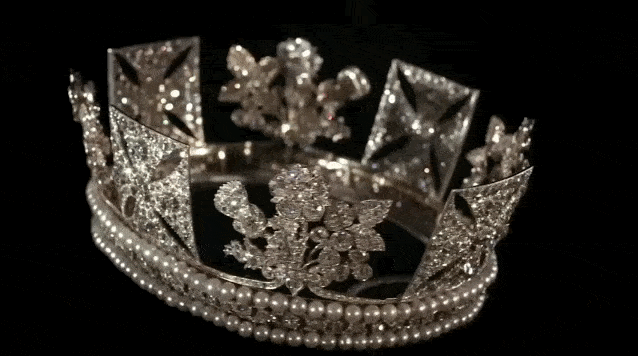
George IV State Diadem
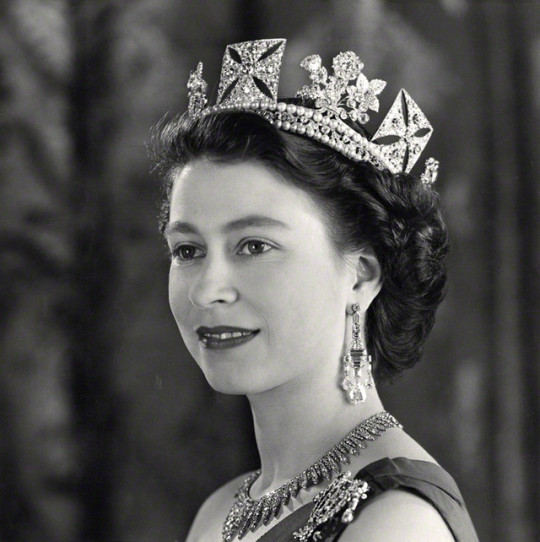
Queen Elizabeth II

Princess Margaret wearing Queen Mary’s Diamond Lozenge Bandeau at a banquet held for the state visit of Queen Juliana of the Netherlands in 1950.
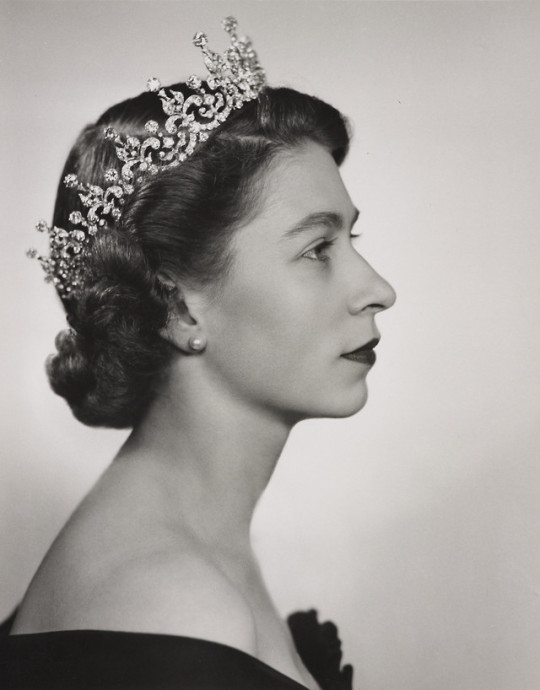

Queen Elizabeth II in her first official photographic sitting as Queen by society photographer Dorothy Wilding.
It took place on 26 February 1952, just twenty days after the accession. A total of fifty-nine photographs were taken by Wilding, showing The Queen dressed in a variety of gowns designed by Norman Hartnell and wearing jewellery including the Girls of Great Britain and Ireland tiara.
The photographs taken during this sitting were the basis of The Queen’s image on postage stamps from 1953 until 1971, as well as providing the official portrait of The Queen which was sent to every British embassy throughout the world.

Princess Margaret wearing the lotus flower Tiara
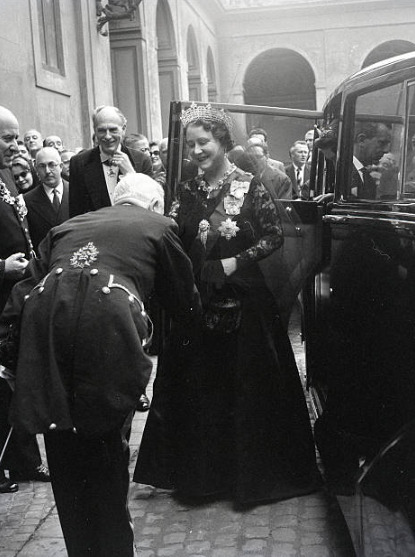
Queen Elizabeth The Queen Mother visiting the Vatican

Princess Margaret of the United Kingdom, 1956

Queen Mary of the United Kingdom wearing the Grand Duchess Vladimir Tiara and Court Dress, 1928
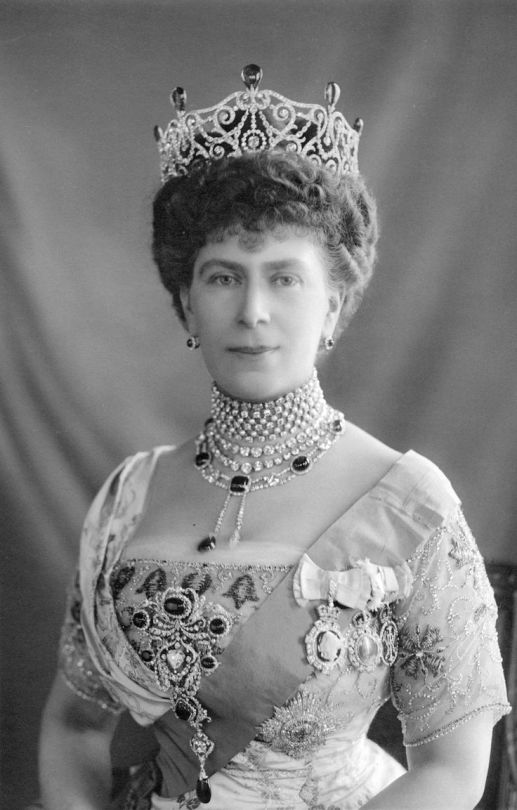
Queen Mary wearing the Delhi Durbar Parure
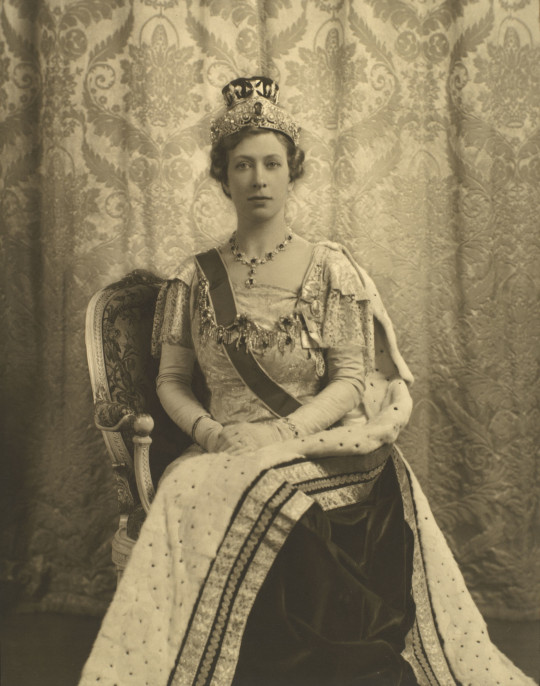
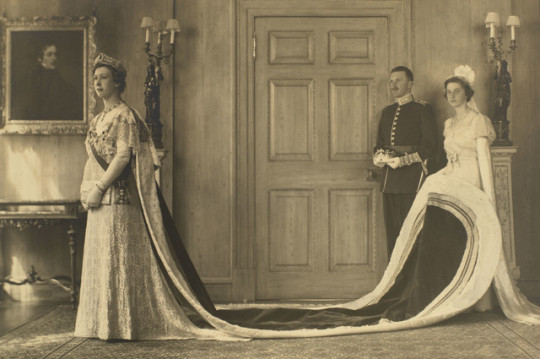
Princess Mary of the United Kingdom, The Princess Royal, Countess of Harewood dressed for the coronation of her brother, King George VI, 1937
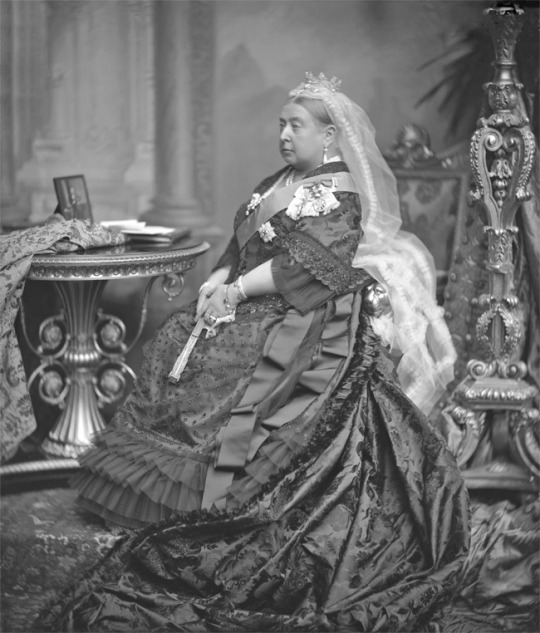
Queen Victoria on her Golden Jubilee, 1887
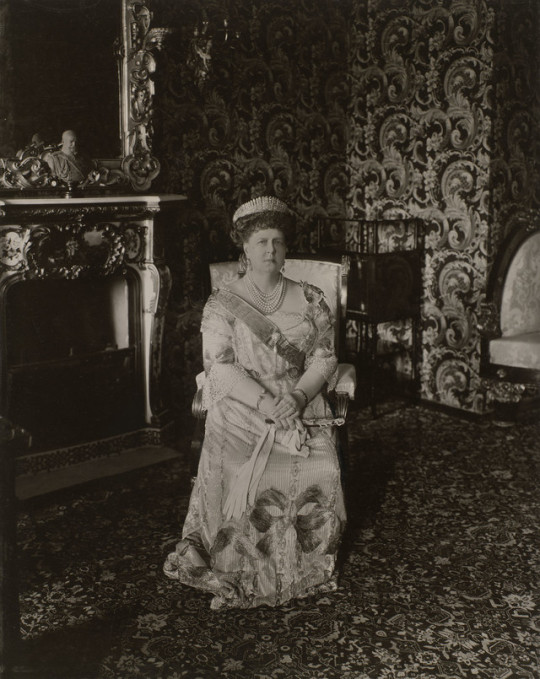
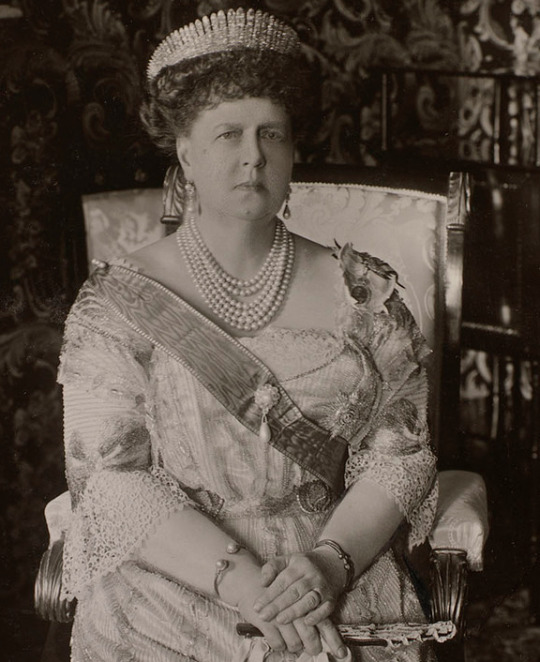
Her Imperial & Royal Highness Marie Alexandrovna was born an imperial Grand Duchess of Russia. She married Queen Victoria’s second son, Prince Alfred, becoming the royal Duchess of Edinburgh in the United Kingdom and went on to become the sovereign Duchess of Saxe-Coburg & Gotha in the German Empire


Empress Alexandra Feodorovna of Russia wearing Russian court dress at the first State Duma of the Russian Empire

Queen Elizabeth II and Prince Philip, Duke of Edinburgh
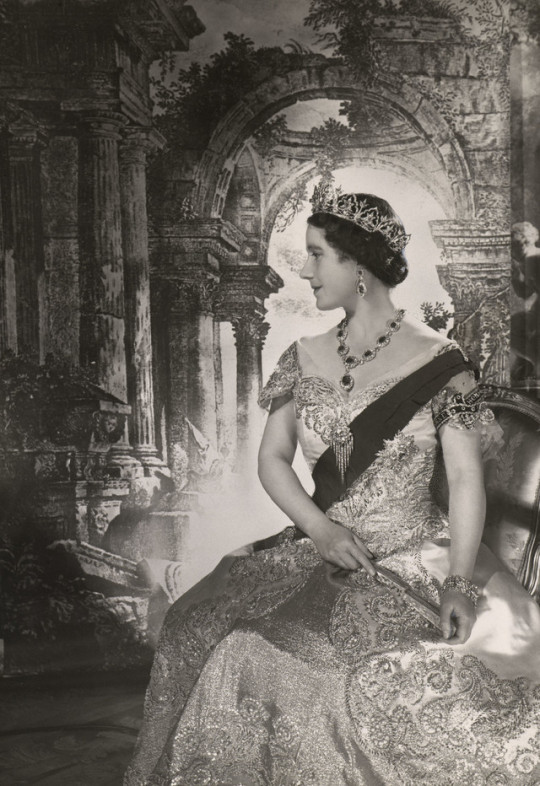
Queen Elizabeth The Queen Mother by Cecil Beaton
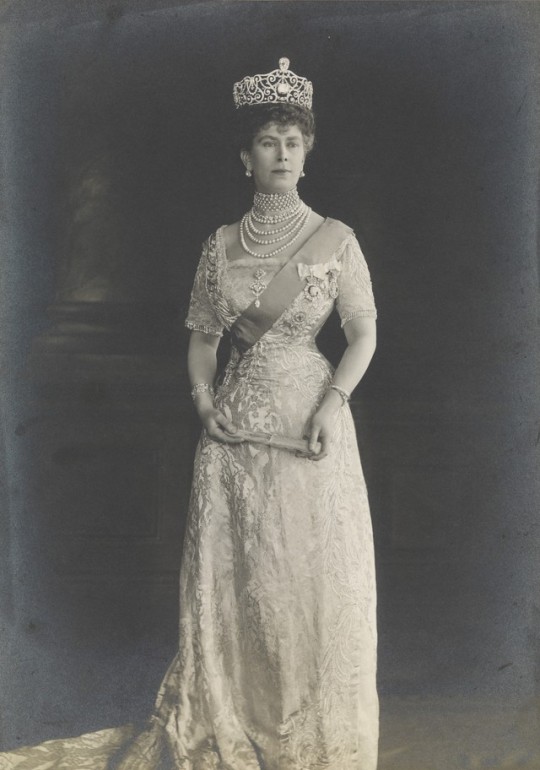
Queen Mary of the United Kingdom and Ireland, Empress of India wearing the Delhi Durbar tiara (x) incorporating the Cullinan III & IV diamonds. The brooch comprises of the Cullinan V, VI and VIII diamonds. The orders on her left shoulder are the Royal Order of Victoria and Albert, Royal Family Order of King Edward VII and the Imperial Order of the Crown of India. The sash and star are the Most Noble Order of the Garter.
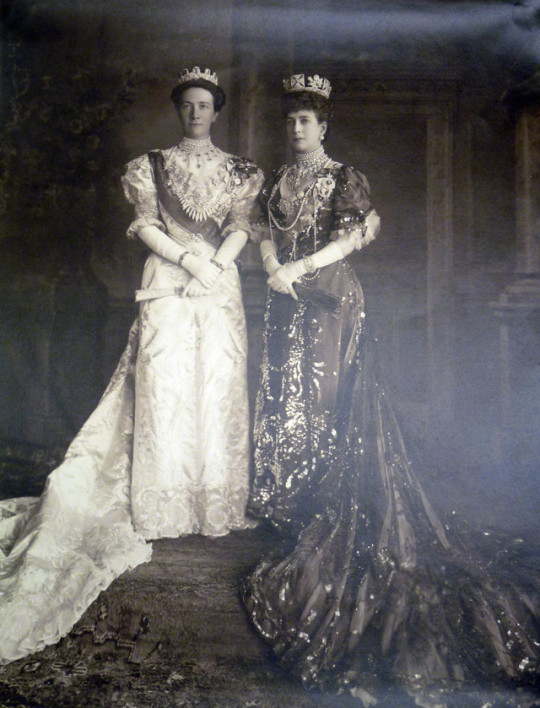
Queen Alexandra of the United Kingdom with Queen Victoria of Sweden, 1907.
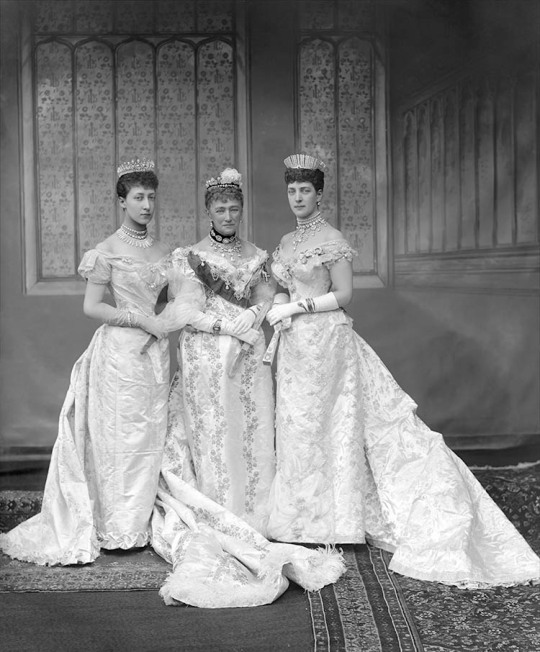
Queen Alexandra of the United Kingdom, Queen Louise of Denmark and The Princess Royal, Duchess of Fife née Princess Louise of Wales at the wedding of the future King George V of the United Kingdom, 1893

Princess Diana, Queen Elizabeth II and Prince Charles at the State Opening of Parliament

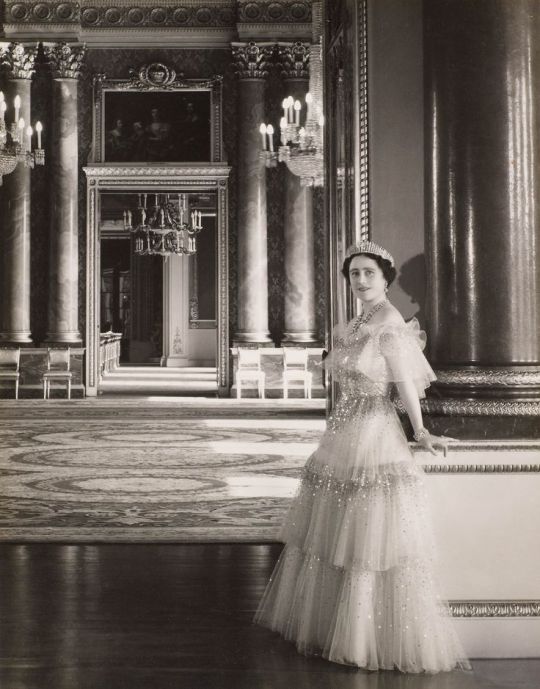
Queen Elizabeth, The Queen Mother

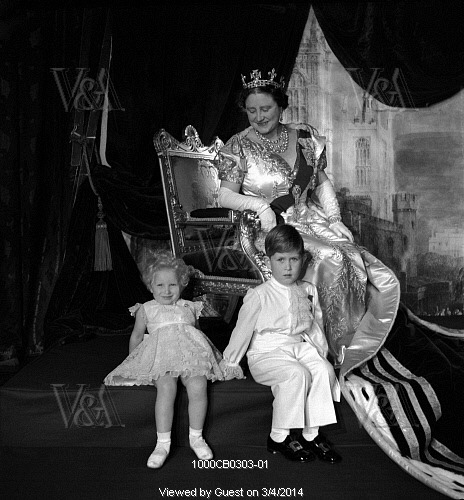
Queen Elizabeth The Queen Mother with Prince Charles and Princess Anne by Cecil Beaton, Coronation Day, 1953
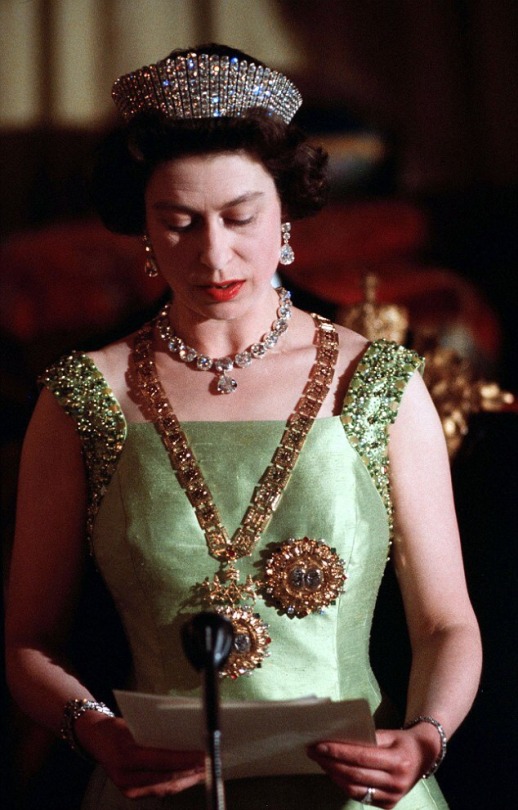
Queen Elizabeth II during a state visit to Ethiopia, 1965
Thank you😊❤️❤️❤️❤️❤️❤️
101 notes
·
View notes